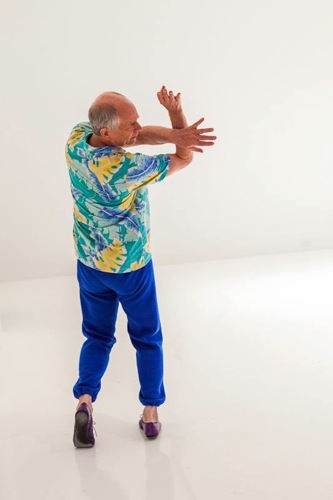Montclair State University’s Peak Performances hosts Douglas Dunn’s Aubade, January 24-February 1.
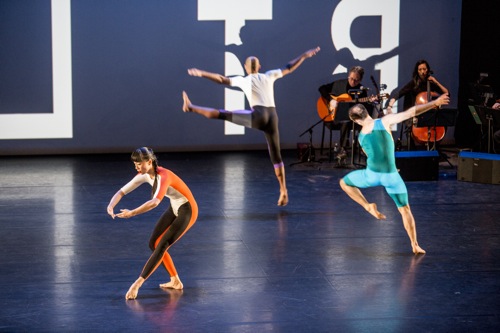
(L to R): Jin Ju Song-Begin, Paul Singh, and Christopher Williams. Visible at bcak: Steven Taylor (L) and Ha-Yang Kim in Douglas Dunn’s Aubade. Photo: Marina Levitskaya
Between the last moments of Douglas Dunn’s new Aubade and the swell of applause, the woman sitting next to me in Montclair State University’s Alexander Kasser Theater turned and said, “It’s so sad!” And yes it was, and no it wasn’t. As Dunn remarked in an interview, an aubade is a song to the sunrise that follows a night of love. You two had a wonderful, perhaps clandestine, time together, but now you must part.
You can think of it this way too: a hero with a degree of hardiness may canter into the sunset; after a certain age (Dunn is 71), you hobble along toward (you hope) a dawning. In the final moment of Aubade, Dunn and his partner and long-time collaborator, Grazia Della-Terza walk hand-in-hand toward the glowing back of the stage, shepherded by Christopher Williams, a much younger dancer, who has emerged by the end of this beautiful evening-long work as Dunn’s alter ego—his stand-in, his stunt man.
Dunn has also acknowledged—cagily—that autobiographical elements have shaped Aubade. However, as a onetime distinguished performer in Merce Cunningham’s determinedly plotless works, a former improviser with the Grand Union, and a choreographer of wildly imaginative dances that tell no obvious stories, he can’t be expected to depict schoolyard wrangles and losses of virginity and beginning dance classes. And yet. . . .
And yet, traces of remembered feelings and events that it’s best not to pin down creep into the piece in elegant, witty, unusual, richly danced ways.
Aubade, commissioned by Montclair State’s major Peak Performances series, owes a great deal to Dunn’s collaborators. Stephen Taylor has composed a superb score, played live from the stage by Taylor (vocals, guitars, and harmonium); Jerome Begin (piano and computer); Ha-Yang Kim (cello); and Cleek Schrey (fiddle). Poet Anne Waldman has contributed spoken text. Charles Atlas’s costumes, video projections, and lighting create an eloquent changeable landscape.
Atlas at his console projects onto the cyclorama spare white lines that may elongate, fatten, meet, merge, form peaks, drop out of sight, and more; lines create smaller and smaller squares, in and out of which numbers dance, growing and shrinking—now randomly seeking, now finding their appointed squares. Colors flood the space. A few birds fly across a dark, mountain-flanked lake. Phantom horses, edged in light, gallop and swerve. But none of this magic is presented for show; every effect—carefully timed and developed—is intimately partnered with the dance.
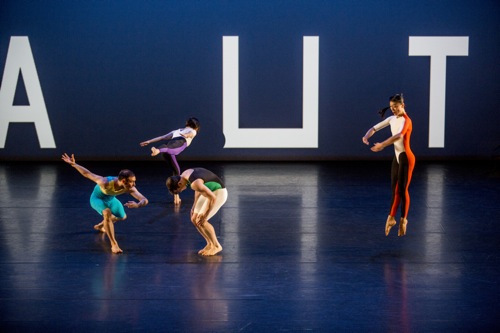
(L to R): Christopher Williams, Alexandra Berger, Jake Szczypek, and Jin-Ju Song-Begin in Aubade. Photo: Marina Levitskaya
At first, the only three people onstage in Aubade are Jin Ju Song-Begin, Timothy Ward, and Schrey. The latter, making his fiddle shimmer, moves to various areas, while Song-Begin and Ward bow in a quite courtly manner, before introducing themselves to each other in “speeches” of clever, expansive dancing. As the relationship progresses, Song-Begin walks on tiptoe away from Ward, then falls backward toward him; he catches her before she hits the floor. This happens three times, and the single horizontal white line on the mauve backdrop musters itself into two little mountains.
Schrey takes his seat with the other musicians when Christopher Williams bounds in with harsh, vigorous jumps and, in effect, lays Ward and Song-Begin to temporary rest.An enigmatic figure from the start—awkward, contorted, unsure, looking up at times—Williams is crouching down, writhing a bit, his hands behind his back, when a squad enters from each side. One group consists of fine Dunn dancers: Alexandra Berger, Emily Pope-Blackman, Paul Singh, Jake Szczypek, and Ward. The other is made up of five students in Montclair State’s dance department and one graduate (Julianne Cullen, Jake Deibert, Kylie Levine, Genna Mergola, Crystal Rodriguez, and Mark Willis). Their names matter, because Dunn has used their talents so well that you can hardly tell them from the more experienced dancers, and because they perform excellently what he has asked of them. Dunn was given space at Montclair State while Aubade was being developed, so incorporating students was an excellent idea, as well as one with autobiographical resonance (he has been teaching a course at NYU’s Steinhardt School for around a decade).
While Williams struggles, the twelve engage in unison and contrapuntal dancing, with breakouts into individual patterns (see that, Merce, wherever you are?), and a bit of horsey partner work. Later, the students are the ones who, clustered behind Song-Begin, push her onto the stage and settle down in a semi-circle to watch her dance, changing their positions from time to time. Grave and intense in a costume that’s a veritable carousel of colors, she’s something—a grave, beautiful, confident woman who can move her arms so rapidly that they blur. When Taylor speaks Waldman’s lines and you hear words like (I may be misquoting) “She is in all my thoughts” and “I swerve to her,” you know about whom he’s talking. When her handsome gown comes off, she’s in black and white, just like her onstage audience. A short reign as queen.
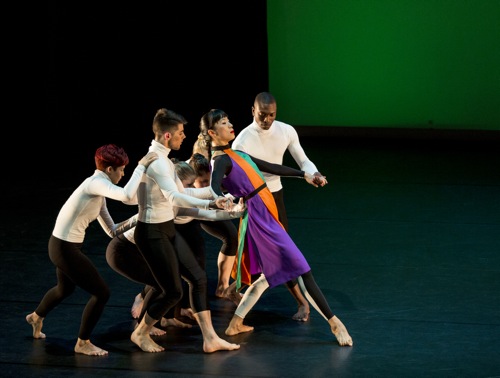
Jin-Ju Song-Begin assisted by (L to R) : Crystal Rodriguez, Jake Deibert, Mark Wilis. (Partly hidden): Kylie Levine, Genna Mergola, Jullianne Cullen. Photo: Marina Levitskaya
Williams enters to manipulate the poses of the watching dancers, and then slips behind Song-Begin, incorporating himself into her amorous attitudes. I thought I heard Taylor ask, “Can you understand how blunt love can be?” If true, that’s more interesting than love being blind. Song-Begin looks Williams in the eye and—just after they’ve pressed their palms together in a kind of vow—raises a leg to stab him in the chest with her pointed toe.
Once only, the word BALLET takes over the backdrop. An epiphany, for sure (Dunn took his first dance class at the Princeton Ballet Society during his college years).The word is replaced by a scene involving some technical wizardry. When Singh and Williams, alone onstage, drop to the floor and begin to wrestle slowly, video images showing them from a slightly different angle appear on the drop behind them. When Pope-Blackman and Szczypek enter, walking on tiptoe, and begin a different kind of intricate duet, their images also appear, and gradually, the two dances merge onscreen.
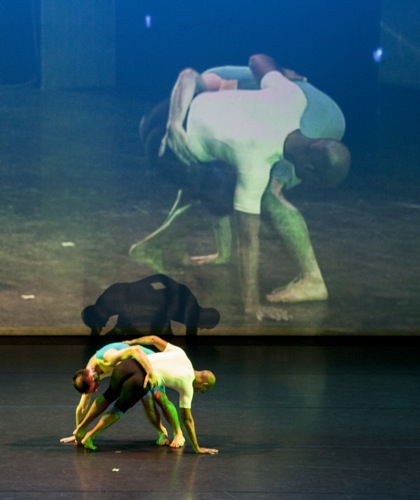
Paul Singh and Christopher Williams dance with their shadows and their doubles. Photo: Marina Levitskaya
Dunn enters Aubade late, wearing dark glasses and carried on by cast members. Della-Terza makes intermittent appearances in a corner, involved in her own quiet movements. This is when the night horses gallop behind the dancers. This is when the musicians first play the melody of the ravishing aria (minus the soprano) that threads though Hector Villa-Lobos’s Bachianas Brasileiros No. 5.
There is much to take in. The projected countdowns between several sections (to cover costume changes) give us time to ponder, but also they gun up our pulses in anticipation of what’s to come. We might guess that Dunn would dance with a certain beguiling awkwardness—an intelligent puppet aware of what his handler, fate, has in store. We can be sure that he and Della-Terza will dance together apart from the others. But who could guess that Singh would rise out of the orchestra pit in a robe becoming to a guru and gain followers eager to copy his moves? Would we have expected to hear Taylor sing “The Water is Wide?” (Remember the 1960s? Baez and Dylan and the words,“But love grows old and waxes cold and fades away like morning dew?”) Yet music both by Taylor eases smoothly out of the score, companioning such sounds as the virtuosic jitters that cellist Kim draws from her instrument.
Gazing at Aubade, I feel as if I’m watching a merry-go-round spin. Now this wild-maned horse passes, then comes by again; this time a child is riding it. But is it the same steed? The carousel pauses; people get off; others climb on. The circling begins again—newly populated, still the same.
Maybe, in the final moments of this vividly enigmatic retrospective, Dunn and Della-Terza are just heading for the “Blue Bayou” that Taylor has sung of and a little rest and sunshine, or maybe, like the “I” of that Roy Orbison song, Dunn is thinking of that possibility only way down the line. Lucky us.

